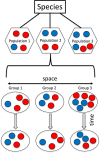Adult sex ratios: causes of variation and implications for animal and human societies
- PMID: 36402823
- PMCID: PMC9675760
- DOI: 10.1038/s42003-022-04223-w
Adult sex ratios: causes of variation and implications for animal and human societies
Erratum in
-
Author Correction: Adult sex ratios: causes of variation and implications for animal and human societies.Commun Biol. 2022 Dec 7;5(1):1341. doi: 10.1038/s42003-022-04296-7. Commun Biol. 2022. PMID: 36477424 Free PMC article. No abstract available.
Abstract
Converging lines of inquiry from across the social and biological sciences target the adult sex ratio (ASR; the proportion of males in the adult population) as a fundamental population-level determinant of behavior. The ASR, which indicates the relative number of potential mates to competitors in a population, frames the selective arena for competition, mate choice, and social interactions. Here we review a growing literature, focusing on methodological developments that sharpen knowledge of the demographic variables underlying ASR variation, experiments that enhance understanding of the consequences of ASR imbalance across societies, and phylogenetic analyses that provide novel insights into social evolution. We additionally highlight areas where research advances are expected to make accelerating contributions across the social sciences, evolutionary biology, and biodiversity conservation.
© 2022. The Author(s).
Conflict of interest statement
The authors declare no competing interests.
Figures





Similar articles
-
Adult sex ratios and reproductive strategies: a critical re-examination of sex differences in human and animal societies.Philos Trans R Soc Lond B Biol Sci. 2017 Sep 19;372(1729):20160309. doi: 10.1098/rstb.2016.0309. Philos Trans R Soc Lond B Biol Sci. 2017. PMID: 28760753 Free PMC article.
-
Adult sex ratio influences mate choice in Darwin's finches.Proc Natl Acad Sci U S A. 2019 Jun 18;116(25):12373-12382. doi: 10.1073/pnas.1903838116. Epub 2019 Jun 3. Proc Natl Acad Sci U S A. 2019. PMID: 31160459 Free PMC article.
-
Sex-biased survival predicts adult sex ratio variation in wild birds.Proc Biol Sci. 2014 Aug 7;281(1788):20140342. doi: 10.1098/rspb.2014.0342. Proc Biol Sci. 2014. PMID: 24966308 Free PMC article.
-
Adult sex ratio variation: implications for breeding system evolution.J Evol Biol. 2014 Aug;27(8):1500-12. doi: 10.1111/jeb.12415. Epub 2014 May 22. J Evol Biol. 2014. PMID: 24848871 Review.
-
Sex roles and sex ratios in animals.Biol Rev Camb Philos Soc. 2023 Apr;98(2):462-480. doi: 10.1111/brv.12915. Epub 2022 Oct 28. Biol Rev Camb Philos Soc. 2023. PMID: 36307924 Review.
Cited by
-
Causes and consequences of sex ratio variation in plants. A commentary on: 'Life history characteristics and historical factors are important to explain regional variation in reproductive traits and genetic diversity in perennial mosses'.Ann Bot. 2023 Oct 4;132(1):viii-x. doi: 10.1093/aob/mcad092. Ann Bot. 2023. PMID: 37793136 Free PMC article.
-
A male-biased sex ratio increases the opportunity for precopulatory sexual selection but does not change the Bateman gradient.Evol Lett. 2025 Feb 14;9(3):324-334. doi: 10.1093/evlett/qraf001. eCollection 2025 Jun. Evol Lett. 2025. PMID: 40487865 Free PMC article.
-
Biased birth sex ratios of mammals and birds in zoos.Sci Rep. 2025 Jul 1;15(1):20506. doi: 10.1038/s41598-025-05039-4. Sci Rep. 2025. PMID: 40595837 Free PMC article.
-
Harem size should be measured by more than the sum of its parts: Phenology-based measurements reveal joint effects of intrinsic and extrinsic factors on a polygamous herbivore under non-stationary climatic conditions.Ecol Evol. 2024 Feb 5;14(2):e10865. doi: 10.1002/ece3.10865. eCollection 2024 Feb. Ecol Evol. 2024. PMID: 38322007 Free PMC article.
-
Variation in the Adult Sex Ratio and Morphological Traits of Cardisoma guanhumi (Latreille, 1828) in Contrasting Habitats in the Southwest of the Gulf of Mexico.Ecol Evol. 2025 Jul 9;15(7):e71710. doi: 10.1002/ece3.71710. eCollection 2025 Jul. Ecol Evol. 2025. PMID: 40635799 Free PMC article.
References
-
- Wedekind C, Küng C. Shift of spawning season and effects of climate warming on developmental stages of a grayling (Salmonidae) Conserv. Biol. 2010;24:1418–1423. - PubMed
-
- Capdevila P, Stott I, Beger M, Salguero-Gómez R. Towards a comparative framework of demographic resilience. Trends Ecol. Evol. 2020;35:776–786. - PubMed
-
- Katzner TE, et al. Assessing population-level consequences of anthropogenic stressors for terrestrial wildlife. Ecosphere. 2020;11:e03046.
-
- Schacht R, Rauch KL, Borgerhoff Mulder M. Too many men: the violence problem? Trends Ecol. Evol. 2014;29:214–222. - PubMed

